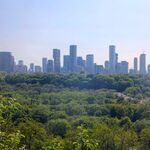crs1026
Superstar
I'm surprised that you're surprised by that.
Not meaning I was surprised really, certainly not new information - more - gosh, it really is those places.
The quandry for me (Your list of factors is quite spot on, I thought) was - how much of this is changeable purely through road redesign and physical change, versus how much of it can only be changed by changing behaviour.
The change factors that I would credit some success this year (having no data to support, purely an observation) are
a) the staggered walk-before-green timing change is an improvement and is training drivers to give way before making turns
b) the renewal of visible police enforcement is creating deterrence
c) attitudes and expectations about speed and travel time are slowly changing... the percent of drivers who accept the need for patience and who give themselves more time to get places has risen a bit.
d) lowering speed limits on many streets
Physical road redesign is great idea but works slowly given budgets etc. Needs to be done, but there have to be drivers accepting different ways to drive on existing roads to get there.
- Paul








